The main landmarks
Individual actions
Acting individually is not enough…
Shifting towards an ecological society implies a global effort, in order to stop climate change but also the destruction of species and resources. If we think about climate change, for instance, meeting the 2°C goal of the Paris Agreement would entail lowering U.S. greenhouse gas emissions by at least 75%.
Individual efforts could seem powerless facing those issues. However, when associated with actions from governments and companies, they are nonetheless essential. A recent study from the French consulting firm Carbone 4 shows the importance of shared responsibility between citizens, governments and companies when facing climate change. It shows that citizens’ eco-friendly behavior and investments could achieve a quarter of total efforts to be made. The remaining efforts (3/4) would have to be achieved through a systemic change, hence our demands towards governments and companies.
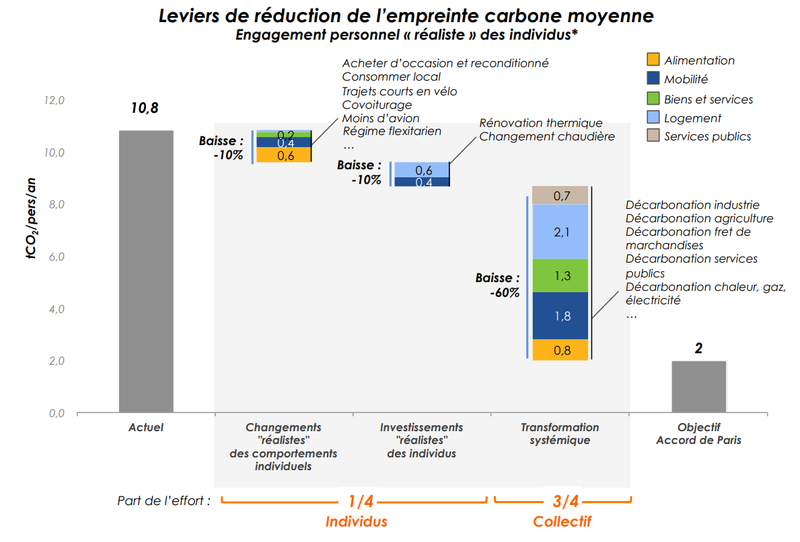
… but yet has a significant impact
The study also shows that individual actions, when not symbolic or superficial, do make a difference. One scenario shows that “heroic” changes from individuals (eco-friendly behaviors) coupled with relevant investments could achieve 50% of the Paris Agreement’s goals regarding decrease in greenhouse gases emissions. However, this scenario would imply radical changes in our way of life.
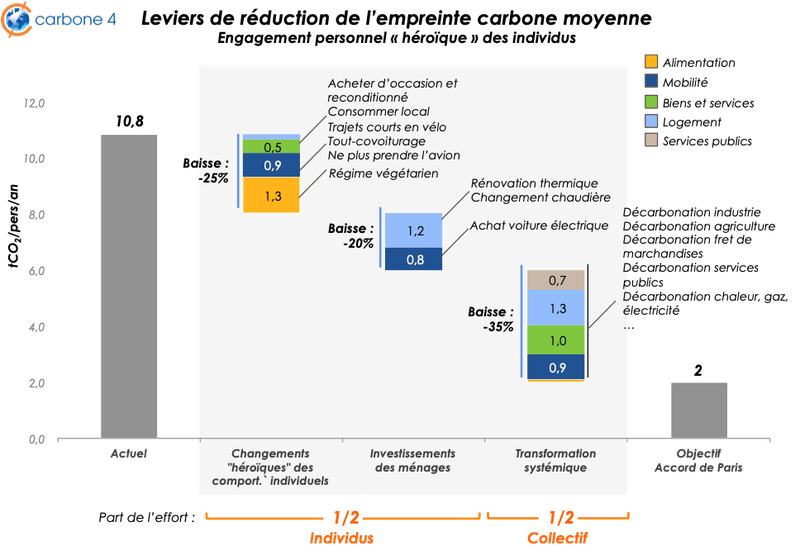
Less consumption, more cooperation
As citizens and consumers, taking part in the global effort means questioning every aspect of our way of life: what we eat, how we travel, how we invest our savings, how we dress, how we use digital tools and how we consume energy. The association Avenir Climatique has put online an excellent tool to identify its main greenhouse gas emissions sources. Making progress towards a sober lifestyle does not necessarily mean a giving up our well-being. Quite the opposite! Repairing bikes in workshops, meeting neighbors when asking to borrow some tools are numerous occasions of bonding with others while saving money. A few examples of actions have been listed below. The goal is to extend the impact of the Manifesto by helping people to understand the issues and to find ways to act.
Understand environmental issues
Global environmental issues... our generation hears about them almost every day: but what issues are we talking about?
Our generation was born in a globalized society with exponential growth due to a set of socio-economic factors, such as the extraction of raw materials (left part of the graph). Our activities have an impact on our environment, and that is completely natural. Nevertheless, population growth coupled with a change in our way of life - more particularly the thermo-industrial society that appeared two centuries ago - has also led to an exponential degradation of our environment (loss of biodiversity, emissions of gases causing global warming, etc.) (right-hand side of the graph) and the depletion of mineral and fossil resources.
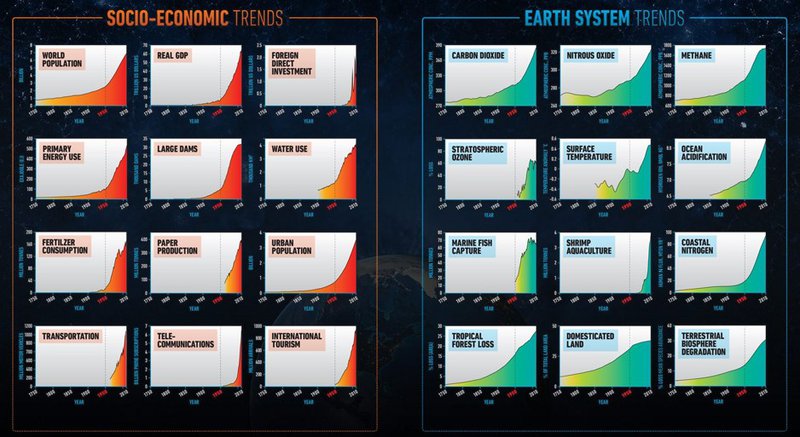
We live in an environment of limited resources. As a result, these extremely rapid growth rates led to an overshoot in many of our renewable resources (particularly animals and plants) in the 1980s. Since that time, we have been eroding the natural capital of our planet, over-exploiting its biocapacity. Our yearly ecological footprint is greater than what our planet can a absorb in a year. .
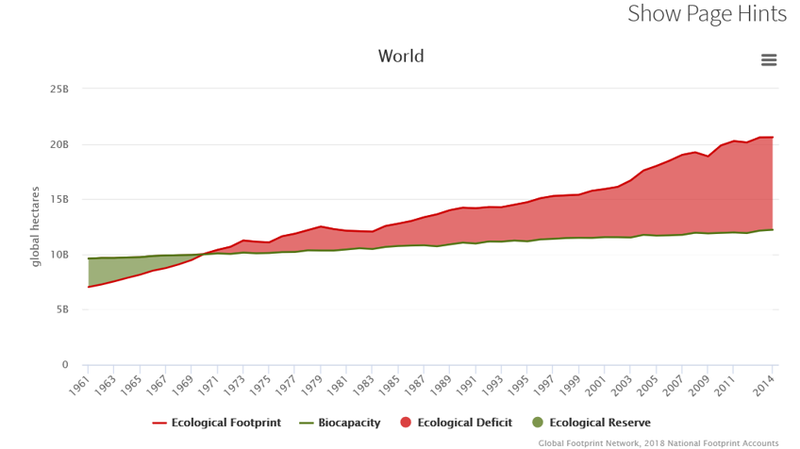
More specifically, researchers at the Stockholm Resilience Centre have identified 9 planetary boundaries that should not be exceeded if humanity wants to be able to live in a safe ecosystem, i.e. to avoid sudden and unpredictable changes in the global environment (Rockström et al., A safe operating space for humanity, Nature (2009)). Beyond these biophysical boundaries, we do not know how ecosystems behave. To quantify these limits, these scientists assessed the environmental conditions in which humanity has prospered over the past 10,000 years (geological period called the Holocene).
In addition, for certain boundaries and physical phenomena, impacts on ecosystems can reach tipping points, causing irreversible disruption.
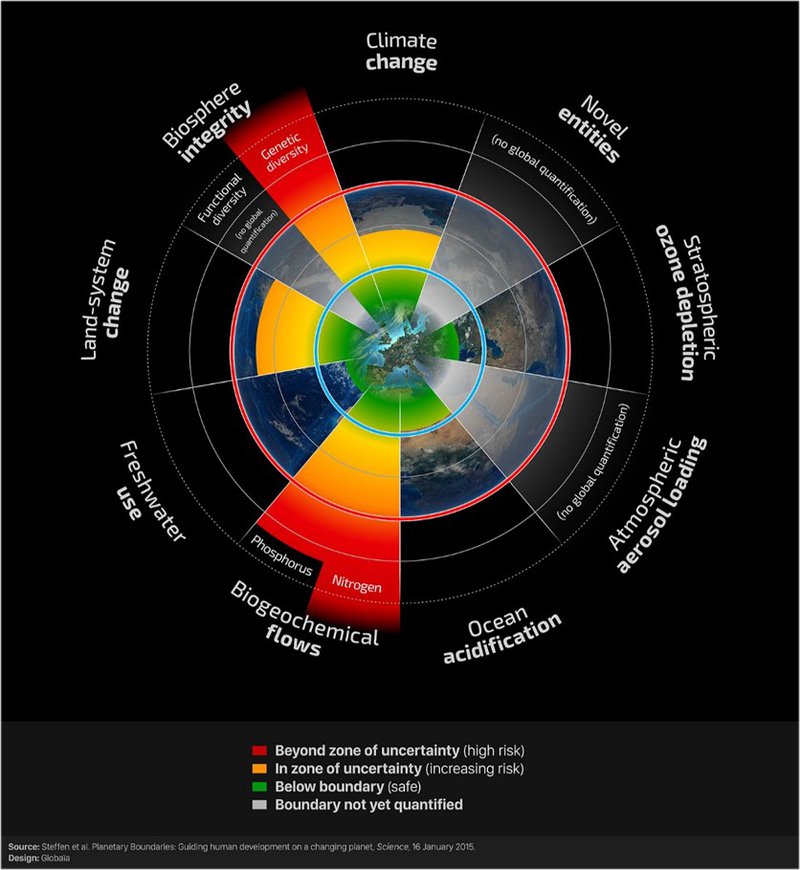
To discover the concept of planetary boundaries in a video: Johan Rockström TED Talk.
Among these limits, 2 have been overshot: the loss of biodiversity (genetic diversity of species) and the disruption of biogeochemical flows (phosphorus and nitrogen). The graphic does not show climate change as being exceeded, since the observed global warming is still +1°C. Nevertheless, the scientific article points out that because of the inertial effect of the greenhouse effect and socio-economic changes, i.e., what has already been emitted and what we predict will be emitted into the atmosphere, the threshold of 2°C average global warming will be exceeded.
Here are some links to deepen your knowledge of planetary boundaries and the mechanisms involved:
🌡️ Climate change
- A synthesis of the 5th IPCC report (Intergovernmental Panel on Climate Change)
- “Climat: comment tout peut changer” : dernier livre de Vincent Rondreux, auteur du blog DrPetrole&MrCarbone, pour informer pédagogiquement des non-scientifques et initier l’envie et guider leur changement de mode de vie.
- Climate change by Bozeman Science.
- Et qu’en est-il du réchauffement climatique en France? Voici quelques éléments de réponse proposés par Le Réveilleur.
🌳 Biodiversity loss
- Towards a 6th mass extinction?
- Summary of the first IPBES report (The Intergovernmental Science-Policy Platform on Biodiversity and Ecosystem Services).
- The report summarized in video by the IPBES secretariat.
📉 Disruption to biogeochemical cycles (nitrogen and phosphorus)
- Environmental pollution from mineral nitrogen inputs to agriculture : Eutrophication.
- Phosphorus: an essential nutrient for the plant whose mineral resource will be depleted in a few decades.
Tous ces enjeux sont interdépendants, et certains secteurs d’activité sont particulièrement responsables des impacts pour chaque enjeu. L’Institut des Futurs Souhaitables a développé un outil pédagogique de qualité pour comprendre ce système complexe, explicitant les tensions entre activités et enjeux.
The changes in lifestyles that we collectively achieve on a global scale, the natural capital available, the pollution of ecosystems, biophysical conditions, and the standard of living and human population will decisively influence the world in which we live. This major challenge calls for the integration of the knowledge of economists, engineers, climatologists and other stakeholders (politicians, industrialists, associations, etc.) in order to model the future and evaluate sustainable development policies in a comparative way. A famous example is the Meadows (or Club of Rome) report of 1976, which modeled different socio-economic and ecological trajectories that our society could follow. To find out more: a documentary that interviews the authors to explain the genesis of the project:
To summarize this section: our current system and lifestyles are causing potentially irreversible changes in environmental conditions that put our life in danger and that of millions of other species. This is a decisive moment to engage collectively, to thoroughly review our lifestyles, in order to halt these environmental changes and adapt to those already underway.
